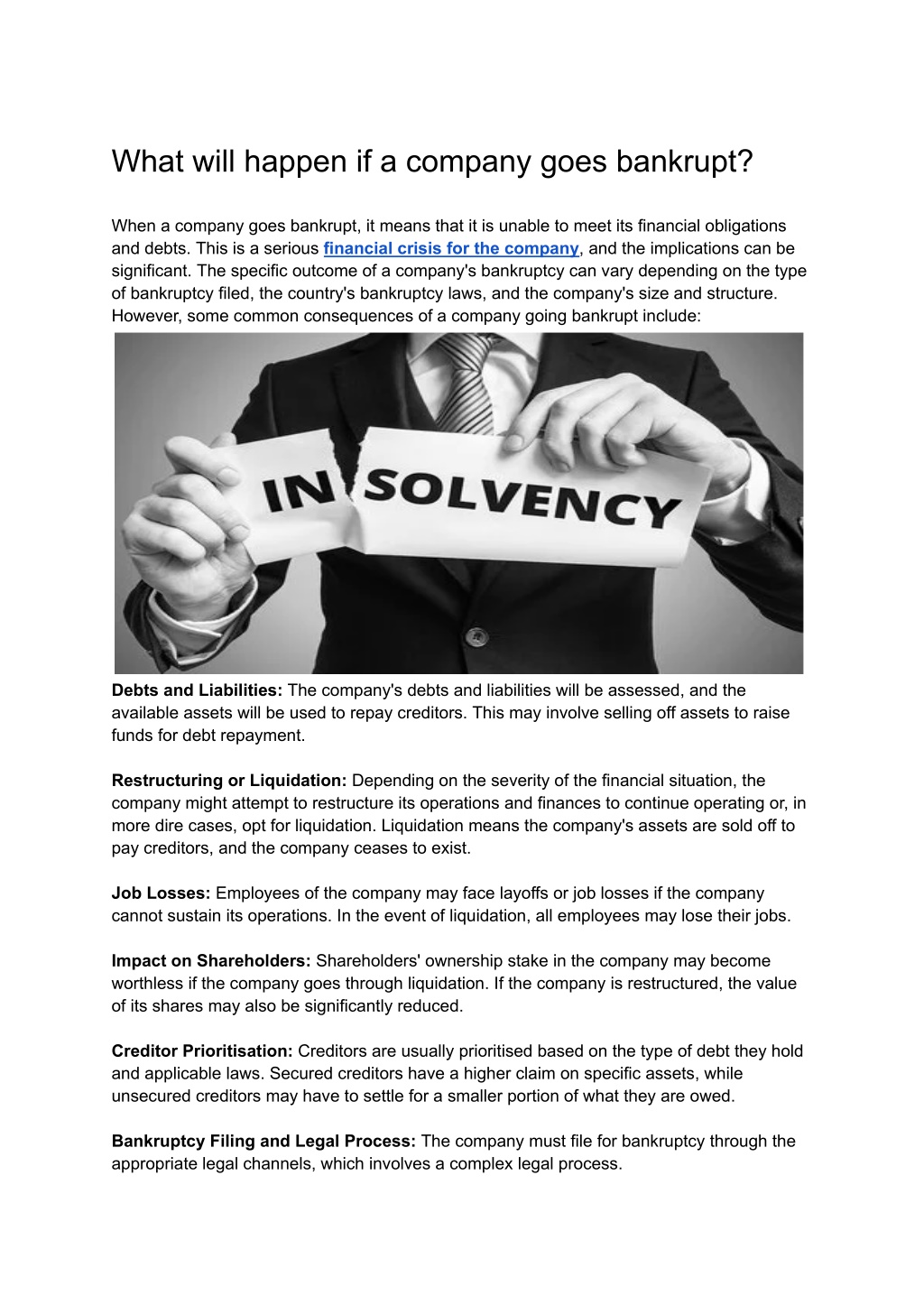Company Administration Explained: What Happens When Companies Go into Liquidation?
Company Administration Explained: What Happens When Companies Go into Liquidation?
Blog Article
The Refine and Consequences of a Firm Entering Administration
As a business faces economic distress, the decision to enter administration marks an essential point that can have far-ranging ramifications for all included celebrations. The procedure of entering administration is detailed, including a series of steps that intend to navigate the company towards potential healing or, in some instances, liquidation.

Introduction of Firm Administration Process
In the realm of company restructuring, an important first step is acquiring a thorough understanding of the detailed firm management procedure. Firm management describes the formal insolvency procedure that aims to rescue a monetarily distressed business or accomplish a far better outcome for the company's lenders than would certainly be feasible in a liquidation circumstance. This process involves the consultation of an administrator, that takes control of the business from its supervisors to evaluate the economic situation and figure out the very best training course of activity.
During administration, the company is approved protection from lawsuit by its lenders, supplying a halt duration to formulate a restructuring plan. The administrator deals with the firm's management, lenders, and other stakeholders to develop a strategy that may entail offering the company as a going worry, reaching a company volunteer setup (CVA) with creditors, or ultimately positioning the business into liquidation if rescue efforts confirm futile. The key objective of firm management is to optimize the return to lenders while either returning the firm to solvency or closing it down in an organized manner.
Duties and Duties of Administrator
Playing a critical function in managing the company's decision-making procedures and monetary events, the manager presumes significant duties during the business restructuring procedure. The main obligation of the manager is to act in the very best interests of the business's creditors, aiming to accomplish one of the most positive outcome feasible. what does it mean to go into administration. This involves conducting a thorough analysis of the business's economic circumstance, developing a restructuring strategy, and executing techniques to take full advantage of returns to lenders
Additionally, the manager is liable for communicating with different stakeholders, consisting of employees, suppliers, and governing bodies, to make sure transparency and compliance throughout the administration procedure. They should also communicate successfully with investors, giving routine updates on the firm's progress and seeking their input when required.
In addition, the administrator plays a crucial duty in handling the everyday operations of business, making crucial choices to maintain continuity and maintain value. This includes examining the stability of various restructuring alternatives, working out with lenders, and ultimately directing the company towards a successful departure from management.
Impact on Firm Stakeholders
Thinking an important placement in looking after the company's decision-making processes and economic affairs, the manager's activities throughout the corporate restructuring process have a direct influence on various company stakeholders. Shareholders might experience a decrease in the value of their financial investments as the firm's economic problems are attended to. Lenders, consisting of loan providers and suppliers, might deal with uncertainties pertaining to the repayment of debts owed to them. Employees usually experience task insecurities as a result of potential discharges or modifications in job conditions as part of the restructuring efforts. Clients might experience disruptions in services or item availability during the management process, affecting their trust and loyalty in the direction of the firm. Additionally, the neighborhood where the business operates can be impacted by possible work losses or modifications in the business's procedures, influencing local economies. Effective communication from the administrator to stakeholders is essential in taking care of expectations, alleviating issues, and promoting openness throughout the management process.
Lawful Ramifications and Obligations
Throughout the procedure of business management, mindful factor to consider of the legal implications and responsibilities is vital to ensure compliance and secure the passions of all stakeholders entailed. When a company enters management, it causes a collection of lawful demands that should be stuck to. Among the key commitments is for the appointed administrator to act in the most effective rate of interests of the business's financial institutions. This responsibility requires the manager to carry out complete investigations right into the firm's affairs, analyze its financial setting, and establish a technique to take full advantage of go back to lenders.
In addition, legal ramifications emerge worrying the treatment of staff members. The manager needs to comply with employment laws concerning redundancies, staff member rights, and responsibilities to provide essential info to staff member representatives. into administration. Failure to abide with these legal requirements can cause lawsuit against the business or its administrators
Additionally, the business going into administration may have contractual responsibilities with different celebrations, including property owners, providers, and customers. In essence, understanding and satisfying legal obligations are crucial facets of browsing a business through the management process.
Techniques for Company Recuperation or Liquidation
In taking into consideration the future direction of a company in management, calculated planning for either recuperation or liquidation is necessary to chart a feasible path onward. When intending for firm healing, key approaches may consist of carrying out a detailed analysis of the business procedures to identify inadequacies, renegotiating contracts or leases to boost cash circulation, and executing cost-cutting measures to improve profitability. Furthermore, seeking brand-new financial investment or financing alternatives, branching out earnings streams, and focusing on core expertises can all add to an effective recovery plan.
Alternatively, in situations where firm liquidation is deemed the most ideal strategy, approaches would entail making best use of the value of properties via reliable asset sales, resolving arrearages in an organized way, and abiding by legal demands to make sure a smooth winding-up procedure. Communication with stakeholders, including financial institutions, employees, and customers, is vital in either circumstance to keep content openness and take care of assumptions throughout the recovery or liquidation process. Ultimately, choosing the right technique depends on an extensive evaluation of the business's monetary health and wellness, market setting, and long-lasting potential customers.
Final Thought
To conclude, the process of a business going into administration involves the appointment of a manager, that handles the obligations of handling the company's events. This process can have substantial effects for different stakeholders, including shareholders, employees, and lenders. It is very important for companies to meticulously consider their choices and techniques for either recouping from monetary troubles or proceeding with liquidation in order to mitigate possible legal effects and responsibilities.
Company management refers to the formal bankruptcy procedure that intends to rescue a monetarily distressed firm or accomplish a far better result for the firm's lenders than would certainly be possible in a liquidation circumstance. The administrator functions with the company's administration, creditors, and other stakeholders to devise an approach that may entail marketing the company as a going concern, reaching a firm voluntary plan (CVA) with financial institutions, or ultimately positioning the company into liquidation if rescue attempts confirm futile. The main objective of company administration is to make the most of the return straight from the source to financial institutions while either returning the company to solvency or closing it down in an organized fashion.

Report this page